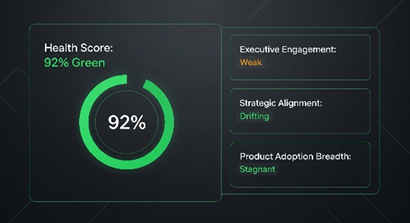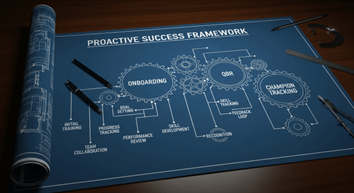Why Your Client Health Score is a Rearview Mirror: A Guide to Proactive Relationship Management
- vincelupe
- Aug 11
- 6 min read
Updated: Oct 3

It’s a scenario that plays out in B2B companies every quarter…
A customer success manager scans their dashboard & breathes a sigh of relief, seeing a key account marked with a vibrant, green “95% health score…”
A month later, the same "healthy" client submits their cancellation notice, leaving the team scrambling & confused.
What went wrong?
The problem often isn’t the team – it’s the tool.
The traditional client health score promises a single source of truth – but, in reality, it often creates an illusion of safety.
It's a lagging indicator – a rearview mirror reflecting past behavior – like product usage & support ticket volume.
That rearview mirror – the client health score – can't see the road ahead.
This isn't just a feeling; it's a well-documented business reality.
As the Harvard Business Review points out:
between 60% & 80% of customers who churn reported being "satisfied" or "very satisfied" in their last survey – proving that satisfaction does not equal retention.
To build a truly churn-resistant business, you must stop looking in the rearview mirror – and start looking through the windshield.
This guide breaks down the flaws in traditional client health score models & introduces a more proactive framework for understanding, measuring, and managing your client relationships.
The Flaw in Traditional Client Health Scores

The concept of a client health score was born from a good intention: the desire to create a simple, data-driven snapshot of the customer relationship.
In theory, it’s a single metric that can warn you of potential customer churn.
However, in practice, its foundation is often flawed.
The critical flaw lies in the data these scores typically measure.
Most are built on a foundation of simple, easily–quantifiable usage metrics:
log-in frequency,
number of features used, or
volume of support tickets submitted.
While this data shows activity, it doesn't always correlate with the value a client is receiving or their strategic alignment with your solution.
A client might have high usage simply because they are struggling, or low support tickets because they've given up on getting help.
More importantly, this purely quantitative approach completely misses the most critical indicators of a relationship's true health: the qualitative signals.
It can't tell you if your key champion just left the company, if the client's corporate strategy has pivoted, or if a new competitor has entered their ecosystem.
Relying only on past activity is what turns your health score into a rearview mirror, leaving you blind to the dangers right in front of you.
From Reactive Metrics to Proactive Signals
To get a true read on client health, we must shift our focus from reactive metrics to proactive signals.
This means moving beyond a simple customer health score to a more holistic framework of "Relationship Intelligence."
The guiding question changes from "How active was this client?" – to "How deeply–embedded & strategically–aligned is our partnership?"
A truly proactive customer success model tracks forward-looking indicators that measure the quality & depth of the relationship.
Here are three of the most critical signals:
Executive Engagement: Are you still connected to the decision-makers?
According to the ChurnZero:
the loss of a key champion or executive sponsor is one of the top leading indicators of potential churn – as it often triggers a re-evaluation of a solution's ROI.
Product Adoption Breadth: How deeply is your solution integrated into their daily operations?
A client using more features and/or expanding access to more teams over time is a strong signal of deepening value; stagnant adoption –, even with high usage of just one feature – can be a significant warning sign.
Strategic Alignment: Are you still solving their most important problem?
A client's business goals can change quarterly.
A proactive approach involves regularly verifying that your solution is still aligned with their top-level strategic objectives – not just the ones they had a year ago.
Focusing on these forward-looking signals allows your team to act – not just react.
This proactive stance has a massive impact on the bottom line; research by McKinsey shows:
such initiatives can lead to a 20-30% increase in customer satisfaction.
The Role of AI in Predictive Analysis

Tracking these proactive signals across an entire client portfolio is a significant challenge.
A busy customer success manager can't be in every email thread or track every stakeholder's sentiment manually.
This is where leveraging technology isn't just an advantage – but a necessity for scaling a proactive customer success function.
At Veridian Growth Solutions, our integrated AI-enabled approach provides this crucial layer of insight.
As founder & CEO, Vince Lupe's, AI strategist partner, Gia can analyze the vast amounts of unstructured data that traditional dashboards ignore.
This includes:
performing sentiment analysis on email communications,
detecting changes in response times from key champions, and
correlating engagement patterns with external events.
This is the foundation of true predictive churn analysis.
The goal isn't for an AI to manage the client relationship – but to empower the human expert.
Gia can surface a data-backed insight – a subtle warning sign that a simple health score would miss – allowing our team to intervene with the right strategy at the right time.
It's the fusion of her analytical power and human partner's strategic intuition that creates a truly predictive, resilient client success model.
Building a Proactive Customer Success Framework

Moving from a reactive to a proactive customer success model requires more than just good intentions – it requires a formal framework.
Building this system is how you turn insights into repeatable processes that drive retention.
While a comprehensive build-out is a deep engagement, here are three foundational pillars you can start thinking about today…
1. Map the End-to-End Client Journey
You cannot be proactive without a map.
This means formally–documenting every key milestone – from the moment the sales handoff is complete – to the renewal conversation.
For each stage, define the desired client outcome, the tasks your team needs to perform, and the potential risks to look out for.
This creates a consistent, scalable playbook for your entire team.
2. Implement a Champion Tracking Program
Your relationship with your client champion – the key person who advocates for your solution internally – is your single most important asset.
A formal program involves identifying these champions, regularly–monitoring their engagement, and – most critically – having a pre-defined "risk playbook" that activates the moment a champion leaves their role.
3. Reframe the QBR as a Strategic Partnership Meeting
Many Quarterly Business Reviews are backward-looking reports on usage.
A truly proactive QBR is a forward-looking strategy session.
The conversation shifts from "Here’s what you did" – to "Based on your upcoming business goals, here’s how we can help you win the next quarter."
This solidifies your role as an indispensable strategic partner – not just a vendor.
Start Looking Through the Windshield
Relying solely on a traditional client health score is like trying to drive a car by only looking in the rearview mirror.
It tells you where you've been – but not where you're going.
As we've explored, this reactive approach leaves you blind to the most critical indicators of future churn – the qualitative signals that define a true partnership.
A proactive customer success strategy doesn't abandon data; it enriches it.
It combines traditional metrics with a framework of "Relationship Intelligence" – tracking executive engagement, strategic alignment, and product adoption depth.
This is how you move from simply measuring activity to truly understanding your clients.
Building this predictive framework is the difference between saving at-risk accounts & preventing them from becoming at-risk in the first place.
If you're ready to stop looking backward – and start building a proactive growth engine – let's connect; reach out to us at VGS to discuss how we can help you look through the windshield & scale with confidence.
Is your business ready for Relationship Intelligence?
If you're ready to stop looking backward – and start building a proactive growth engine – let's connect; reach out to us at VGS to discuss how we can help you look through the windshield & scale with confidence.



